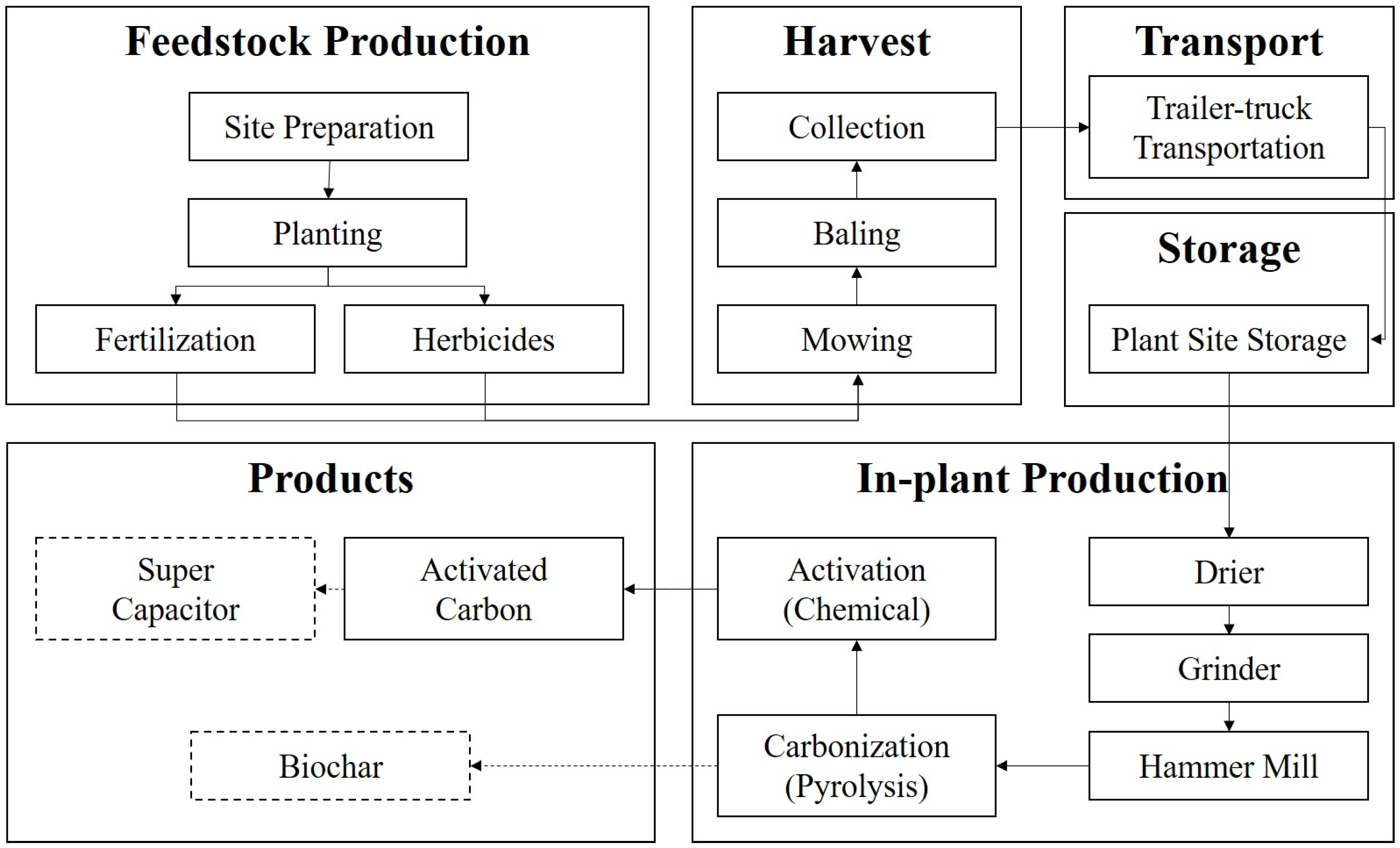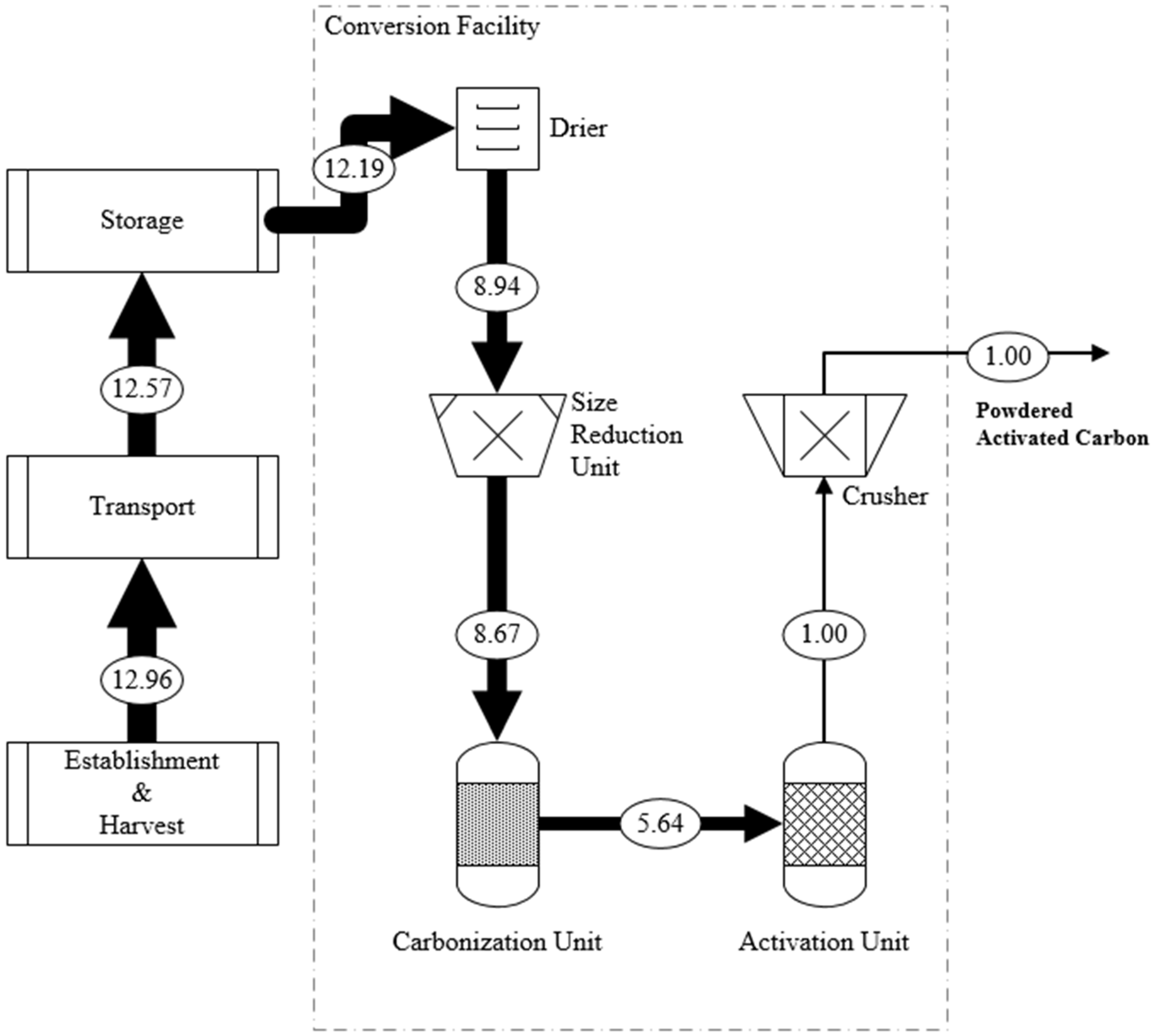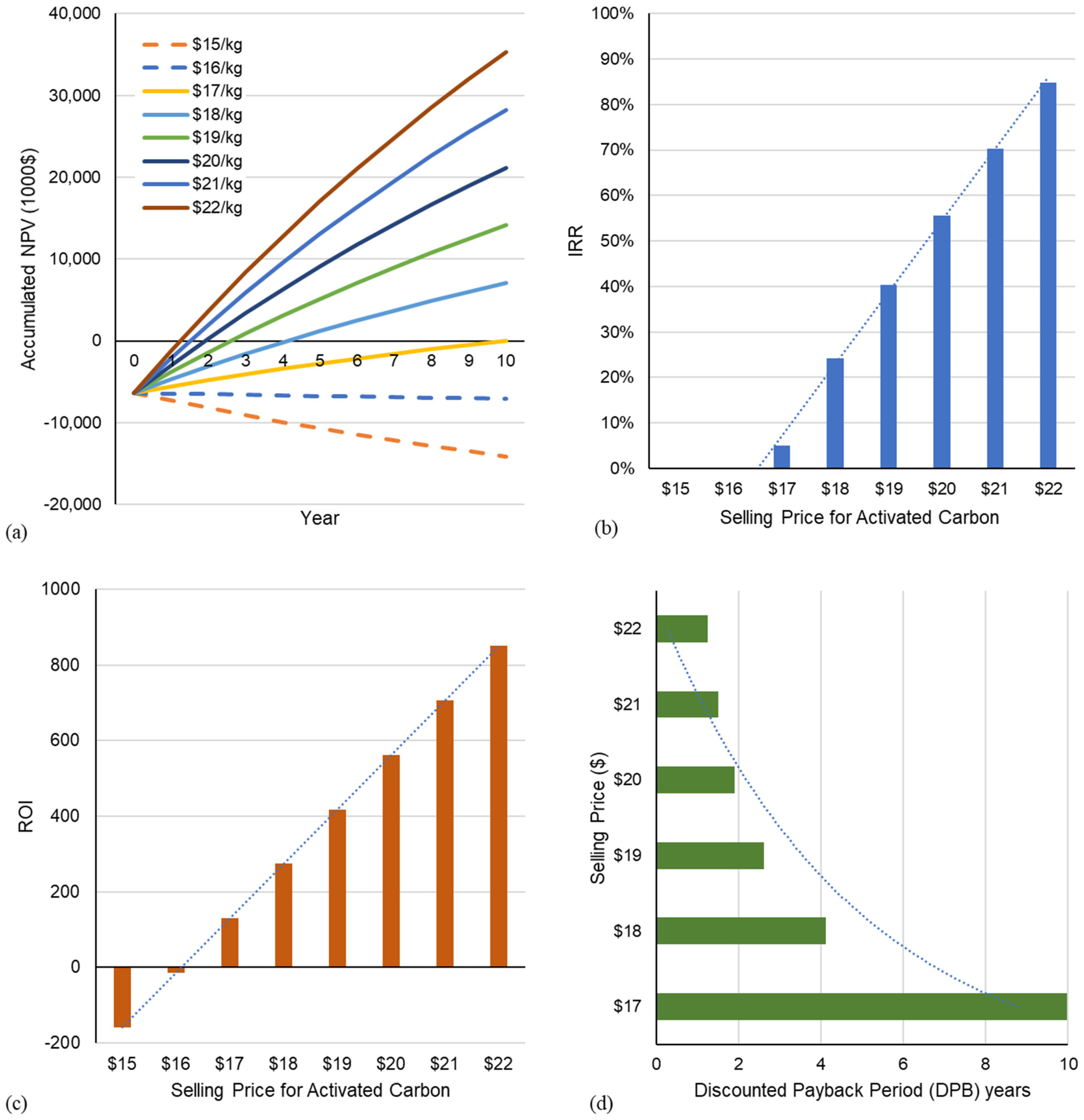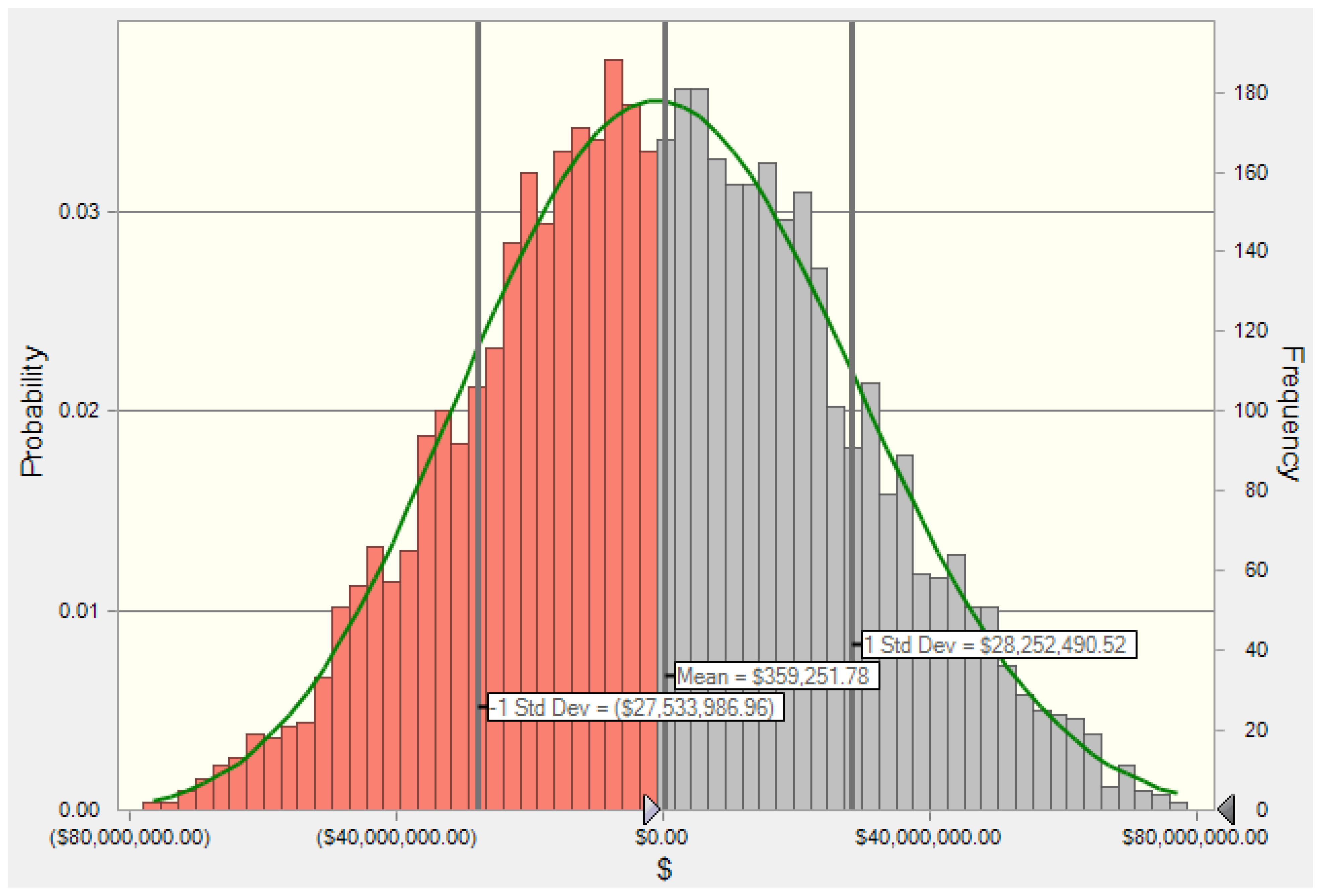1. Introduction
Lignocellulosic materials such as energy grasses and woody biomass are widely recognized as environmentally friendly feedstocks for value-added bioproducts [
1], including for bioenergy products [
2] and carbon sequestration [
3], and as an essential element for the production of active carbon-based material [
4]. Utilizing biomass to develop alternative energy-storage devices with high energy densities is a viable solution due to the uncertainty of fossil fuels and increased environmental concerns [
5]. Supercapacitors are intermediate systems between electrochemical batteries and dielectric capacitors, which can deliver high power practically instantaneously during a few milliseconds [
6]. Carbon supercapacitors are one of the three different types of supercapacitors [
7]. Among the variety of carbonaceous materials such as carbon aerogel, activated carbon [
8], and carbon nanotubes [
9] studied for supercapacitor electrodes, activated carbon is the most widely used material, mainly because of its cost effectiveness, good conductivity, and potential environmental sustainability [
10]. Despite the fact that carbon electrodes are mostly produced from nonrenewable materials such as coal and petroleum, lignocellulosic biomass is known as a renewable and inexpensive feedstock for Activated Carbon (AC)-based supercapacitor electrodes [
11,
12]. In particular, using biomass as feedstock for carbon of energy storage has advantages. First, compared to fossil fuels, renewable biomass material is more sustainable in terms of producing activated carbon in the future. Second, biomass-based products are becoming more and more accepted by the public. Specifically, the growth and production of biomass feedstock would sequestrate carbon and provide other ecosystem services. Third, the value-added utilization of biomass could also facilitate the development of the rural bioeconomy.
The fundamentals behind activation of carbon materials are well studied. The activation of carbon materials is generally conducted either by a physical or chemical process [
13,
14]. In the case of physical activation process using, typically, steam or carbon dioxide, a large amount of the internal carbon mass in carbon structures is removed [
15], while in chemical activation process, the structure of raw material is degraded or dehydrated by chemical-activating agents [
16]. The synthesis techniques of the biomass-based AC capacitors usually include pyrolysis (for carbonization) and activation processes [
17]. Various studies on AC-based supercapacitors integrating the pyrolysis and activation processes showed high specific capacitances of biomass-derived carbon [
18,
19,
20].
Though several studies have been conducted on biomass-based activated carbon for energy-storage applications [
10,
21], the production of lignocellulosic activated carbon for energy storage still faces technical, economic, and environmental challenges. While lignocellulosic materials offer large volume [
22] and are environmentally friendly [
23], they suffer from low carbon yield during AC production [
21], leading to poor economics. Producing low-cost activated carbon compared to other electrode materials is one of the key challenges for the commercial success of the carbon-based supercapacitors [
24].
Life Cycle Assessment (LCA) is an approach that accounts and manages environmental impacts by considering all the aspects of resource uses and emissions associated with an industrial system from either cradle-to-gate or cradle-to-grave [
25]. A full LCA study typically includes four steps: the goal and scope, the inventory analysis, the impact assessment, and the interpretation of results [
26]. LCAs were widely applied to analyze the environmental impacts of the utilization of biomass for various biomass-based products [
1,
27]. Liu et al. (2017b) [
2] compared three bioenergy products from three lignocellulosic feedstocks and found that pellet production presented lower greenhouse gas (GHG) emissions and fossil energy consumption compared to the production of biopower and biofuels. LCA of an ethanol production process via the bioconversion of willow biomass showed 1.69-times higher water consumption compared to gasoline production using the same feedstock, while this process presented 1.41-times less in fossil fuel input [
27]. Environmental impacts associated with the activated carbon production vary depending on different feedstocks and synthetic processes. A cradle-to-gate LCA study of activated carbon from woody biomass showed that the cumulative energy demand would potentially decrease by 35% compared to coal-based activated carbon [
4]. A study on the environmental impacts of activated carbon from olive-waste cakes showed that the impregnation using H
3PO
4 as a chemical activation agent is a major process responsible for the majority of the impacts [
23]. LCA of activated carbon from coconut shells showed that the use of renewable resources for the production of AC would reduce both human toxicity and global warming [
28].
Few studies have focused on the economic analysis of biomass-derived activated carbon [
29,
30]. For AC production from pecan shells in a plant with a capacity of 10,000 kg/day, the production cost was estimated to be USD 2.89/kg [
29]. Considering various feedstocks, the production cost was estimated to be USD 1.56–2.24 per kg of activated carbon [
30].
However, a comprehensive assessment of the economic feasibility and LCA of lignocellulosic-based activated carbon for supercapacitors is still lacking. As the production of electrodes continues to grow, it is critical to develop a baseline analysis of the biomass-derived AC for energy storage and evaluate its performance economically and environmentally. The objectives of this study were to: (1) perform LCA analyzing the environmental impacts of biomass-based activated carbon; (2) conduct a techno-economic analysis of AC-based supercapacitors utilizing the energy crops; (3) compare the environmental impacts of different AC production scenarios; and (4) quantify the economic uncertainty of AC production.
2. Materials and Methods
In this study, energy crops, mainly switchgrass and miscanthus, were utilized to produce highly porous activated carbon for supercapacitor electrodes following a number of steps including biomass establishment, harvest, transport, storage, and in-plant production.
Raw feedstocks, switchgrass, and miscanthus were established in the field, harvested, and stored before delivery to the activated carbon plant. The feedstock was ground and blended to obtain the small particle size in order to facilitate the carbonization and activation thereafter. Similar to the existing works on biomass-based AC production, biochar was prepared by intermediate pyrolysis in a fixed bed with raw materials [
17]. For chemical activation, potassium hydroxide (KOH) solution at a constant precursor-to-KOH ratio of 1:4 by weight was used. The intermediate carbon was then activated at 850 °C.
For economic analysis and LCA, the plant production rate was specified to be 3000 kg per day, which was based on the expected demand of a small-to-medium supercapacitor electrode market, and aligned well with the economical procurement radius of a disperse biomass feedstock [
19].
In addition to the base case, two different scenarios were investigated for LCA. In the base case, KOH was used as an activation agent, but the KOH was not recycled, which affects environmental sustainability due to chemical consumption and waste water production [
31]. In the first scenario, KOH was recycled with a mass loss of 10%. In the second scenario, steam activation, as opposed to activation by KOH, was used. It can be noted that steam activation is a commercial process for the production of AC used for general purposes [
32].
Monte Carlo (MC) simulations were conducted to quantify the uncertainties in the net present value (NPV) due to uncertainties in the production rate, sale price, equipment salvage price, and discount rate, as listed in
Table 1. Uniform distributions were considered for the price of KOH and the discount rate since, for these two factors, all outcomes were equally likely to occur. For other factors with uncertainties, Beta distributions were applied.
2.1. Life Cycle Assessment
2.1.1. Goal and Scope Definition
A cradle-to-gate LCA model was developed to estimate the environmental impacts of AC production for supercapacitors from lignocellulosic biomass. For LCA, two major components for production of AC are biomass feedstock preparation and in-plant AC production, as shown in
Figure 1. Biomass feedstock preparation includes feedstock establishment, harvest, transportation, and storage. In-plant AC production includes size reduction, thermochemical conversion into biochar via pyrolysis, and chemical activation. The functional unit (f.u.) of the system was 1000 kg of energy-storage activated carbon.
2.1.2. Life Cycle Inventory
With the production of 1000 kg of highly porous AC, the material inputs were carried out to estimate the environmental output for AC production (
Table 2). Diesel and lubricating oil were consumed by machines used for handling feedstock in all processes. Fertilizer and herbicides were considered for feedstock establishment causing potential environmental impact. Electricity and KOH were the inputs to the size-reduction, carbonization, and activation steps. Input data were obtained from the field studies, experiments outcomes, and previous studies by [
1,
17,
28,
33].
The establishment and collection of switchgrass and miscanthus includes site preparation, planting, fertilization and the addition of herbicides, mowing, baling, and collection. The equipment used in these processes included a plow, a disk, a harrow, a hopper, a tedder, a rake, a baler, a wheel loader, and a tractor [
2]. Feedstock was then transported by truck to the storage at the processing facility. Driers, grinders, and hammer mills were included for preprocessing. Feedstocks were pyrolyzed at 450 °C for carbonization process, and then activated by being mixed and heated with KOH at 850 °C. The fuel and materials consumption in the harvest system was modified from the study by Liu et al. (2017a) [
1] to be consistent with this study. The utility and transportation were estimated using the USLCI database [
33]. The fuel and materials consumption of carbonization and activation process were adjusted based on the studies by Arena et al. (2016). and Yakaboylu et al. (2019) [
17,
28].
2.2. Economic Feasibility Analysis
A mass balance and flow diagram was developed (
Figure 2) based on field investigations and our previous studies [
1,
17,
34,
35,
36,
37]. It specifies the yield at each step in the carbon production and activation process and identifies the key process equipment items for the manufacturing facility (
Figure 2). This entire diagram was jointly verified by forest operation experts and chemical engineering experts. As seen in this diagram, producing one kg of powdered activated carbon requires 12.96 kg of raw materials on a wet basis. A loss of 3% of dry matter is considered at each stage of feedstock establishment and harvesting, transportation, and storage [
34].
2.2.1. Cost Estimation
In the base case, it was assumed that the plant life was 10 years with a discount rate of 5%, and an annual production yield of 960,000 kg (3000 kg per day for 320 days of operation) of high-performance ACs (
Table 3). To support an AC plant of this size, a supply of 8579 dry Mg of lignocellulosic biomass was required as feedstock.
Equipment cost was estimated based on a combination of vender quotes and literature sources [
29,
30], and capital cost was estimated for all major technical components and processes within the plant using the Lang Factor method [
38]. The total cost was determined by multiplying the total purchase cost for all the major items of equipment by a constant called Lang factor.
where
is the capital cost of the plant,
is the purchase cost of the major equipment unit
,
is the total number of individual units, and
is the Lang Factor. The Lang factor varies regarding three process plant types: solid processing plants (
), solid-fluid processing plants (
), and fluid processing plants (
) [
38]. In this study,
was used for this combined fluid–solid system. Equipment costs derived from the literature were adjusted to year 2019 by multiplying the Producer Price Index (by Commodity for Machinery and Equipment: General Purpose Machinery and Equipment) [
39].
The cost of manufacturing
could be obtained by adding together three cost components: direct manufacturing cost, fixed manufacturing cost, and total general manufacturing cost [
38]. It is denoted in the following equation:
where
is the capital cost of the plant,
is the labor cost for plant operation,
is the raw material costs for feedstock and chemical solution, and
is the utility cost for electricity, water, and natural gas. In this equation, the coefficients for each variable were derived from “total general manufacturing cost” by [
38].
With the assumption that a single operator works 40 h per week for 49 weeks annually, the amount of required labor (
) was calculated based on [
38]:
where
= 0 is the number of processing steps involving particulate solids, and
is the number of other processing steps. In this study, there were ten non-particulate processes: hammer mill, soak tanks, rotary dryer, two rotary kilns, rotary cooler, wash tanks, recovery tanks, storage tanks, rotary dryer, and sieve. For each of the
operators assigned an 8-h shift with a typical 3-week leave, there are 4.5 operators required for a plant that runs 24 h per day. After calculation, the amount of labor per shift was 2.93, and this was rounded up to 3 for later calculation.
2.2.2. Economic Evaluation
Several economic indicators including return on investment (ROI), NPV, internal rate of return (IRR), and discount pay-pack period (DPB) were computed. The ROI was computed as follows:
where:
is the total production cost;
is the total income during the time period ;
is the total investment cost.
The NPV can be computed by considering the difference between the present value of cash inflows and outflows over the entire plant life [
40] and is given by:
where:
The internal rate of return (IRR) measures the return performance of an investment calculated over the whole plant life and is expressed as a percentage [
41].
The discounted pay-pack period (DPB) is the time period required for the pay-back of investment and interest, and it takes the present value of cash flow into account. It is calculated by setting NPV = 0 and a trial and error procedure is applied. The shorter the payback, the more desirable the investment. The DPB was formulated using the logarithm with consideration of the time value of money, which is superior compared to the simple payback period formula [
42].
where:
5. Conclusions
An integrated life cycle and techno-economic analysis was carried out for the production of AC from lignocellulosic biomass catering to a small-to-medium market of supercapacitors. In the entire process, the AC conversion process resulted in the highest impacts in all ten environmental categories. Carcinogenics, ecotoxicity, and non-carcinogenics were the top three impacts of AC production related to human health and ecosystem quality. Among all of the steps involved in the biomass feedstock preparation, the feedstock establishment step had the highest impact on the environment, especially for ozone depletion, respiratory effects, and carcinogenics. The RSP of USD 16.79/kg for activated carbon from lignocellulosic biomass was found to be comparable with the market price of USD 15–50 per kg for supercapacitor carbons. Our base case study indicated that for an investment of USD 6.66 million, the estimated ROI, NPV, IRR, and DPB would be 129.7%, USD 9613, 5%, and 9.98 per year, respectively.
The alternative scenarios suggested that the sustainability of activated carbon for the production of supercapacitors could be improved greatly by reducing the environmental emissions through the recycling of KOH. For instance, the GHG could be further lowered to 83.76%, with the potential upgrading of the AC conversion technology in the alternative cases. However, further research is needed to evaluate the practical feasibility of the suggested alternative routes, especially to investigate the recycling of KOH. As an important source of chemical consumption in the process, the recycling of KOH would not only reduce the environmental burden, but also lower the production cost of the activated carbon. At the same time, the biomass harvesting and logistics are also critical to AC production. The optimization of biomass harvesting and logistics could significantly improve the production of activated carbon from the perspective of the overall feedstock supply chain. In addition, we will also investigate the potential applications of the supercapacitors derived from biomass-based carbon.














